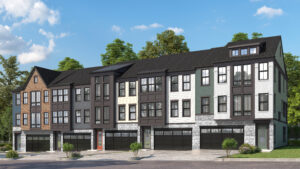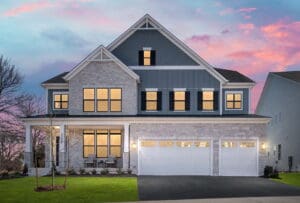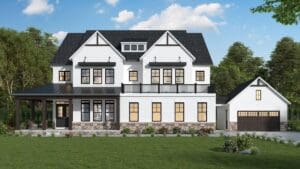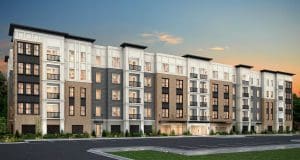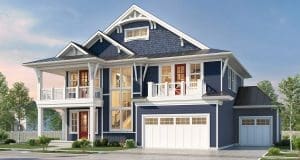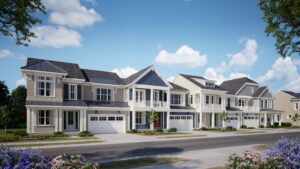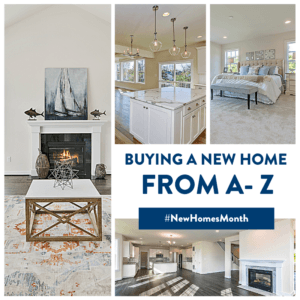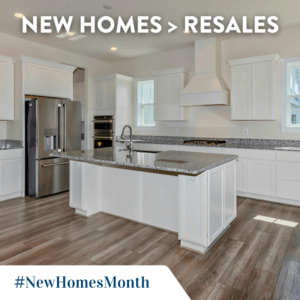For many Americans, spring represents the opportunity for a fresh start, from planting new flower beds, to buying a new home. And as the momentum of home buying season continues to grow, the home building industry is kicking it off by celebrating New Homes Month.
With interest rates currently at historical lows, buyers are eager to find a new living space to call home. According to a recent survey by NAHB, 60 percent of buyers prefer new homes, the highest level since 2007. Additionally, In the wake of the COVID-19 pandemic, more Americans are interested in purchasing homes. According to the National Association of Home Builders’ (NAHB) latest Housing Trends Report, survey responses show that the share of Americans who are considering the purchase of a home in the next 12 months increased in the fourth quarter of 2020.
Throughout the month of April, we’ll be providing tips and resources for new home buyers! Click here to jump to additional resources.
New homes offer so many advantages over older homes: Lower repair and maintenance costs, increased energy efficiency, floorplans and spaces tailored to modern tastes, and much more. Find out why new homes are trending and discover some the many benefits of newly constructed homes below.
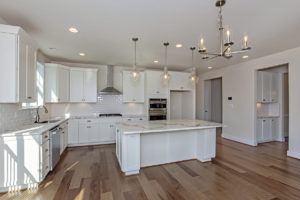
Building envelope: Building codes have mandated increasingly higher energy efficiency standards since they began to address the issue in the late 1970s, says Kevin Morrow, senior program manager for the National Association of Home Builders’ green building programs. “The most recent International Energy Conservation Code came out in 2009 [and] required roughly 17 percent more efficiency than the codes of three years prior,” he says. “So using that as sort of a gauge to how newer homes should perform from an efficiency standpoint compared to older homes, it’s pretty clear that just as homes meet code, they are going to be more efficient.”
Energy Efficiency: Newly constructed homes use energy more efficiently in two ways, Morrow says. First, they tend to have a tighter-sealed building envelope that helps prevent conditioned air—cool air in the summer, warm air in the winter—from escaping. Features that create this envelope include higher-efficiency insulation, doors, and windows. “Gone are the days of the single pain window … now I think you are starting to see triple- and quadruple-paned windows,” Morrow says. “These are windows that are designed to really minimize the transfer of heat either from warm to cold or vice versa, and they of course will help the building envelope.”
Green appliances: The more energy-efficient mechanics of the house also help reduce utility bills for new home buyers, Morrow says. Newly-constructed homes often include green systems and appliances—like high efficiency stoves, refrigerators, washing machines, water heaters, furnaces, or air conditioning units—that homes built years ago might not. “The conditioning equipment is usually considered to be one of the larger energy consumption devices, but certainly those kitchen appliances matter,” Morrow says. Existing homeowners can always retrofit their property or buy higher-efficiency appliances, but doing so requires a potentially significant expense.
Fewer repairs: The features of newly constructed homes should also hold up better than those of existing homes, which may have experienced years of wear and tear, says Evan Gilligan of Mandrin Homes. “People will buy [previously-owned] houses and then the carpet needs to be replaced or it needs to be repainted, or it needs new appliances, or the flooring is shot,” Gilligan says. “When they buy a new home in today’s market, it really is new.”
Less maintenance: At the same time, today’s new homes are engineered specifically to minimize maintenance requirements. For example, Costello says his company uses composite products for a home’s exterior trim instead of wood, which could rot or need repainting. “You buy a used house you don’t know what you are getting, you might have to do a lot of maintenance,” Costello says. “We are trying to look down the road and make things as easy as possible for the homeowner so they can enjoy living there and not have to be saddled with maintenance.”
Warranty: In addition, builders often agree to take care of the repair work that becomes necessary in your newly constructed home for at least the first year. “A new home is generally fully warrantied by the builder for a minimum of a year and most of all the other components are warrantied for extended periods,” says Jack McCabe. So if your roof starts leaking or the heater breaks during the warranty period, your builder will pick up the tab for the repairs. “When you buy a resale home, even if you have a home inspection done, it still does not turn up hidden defects that you don’t find out about a lot of times for two years,” McCabe says.
Fire safety: Newly constructed homes often include fire safety features that may not be present in properties built years ago, Gilligan says. “We use fire retardant in our carpeting and in our insulation,” he says. In addition, all newly constructed homes are required to include hard-wired smoke detectors. These devices can provide better protection than battery-operated smoke detectors, which can fail to perform if their battery runs out, Morrow says. “Hard-wired [smoke detectors] run on the electricity of the house and then have a battery backup for if the house power goes out,” he says.
Concessions: Individual sellers often have an emotional attachment to their property that can blind them to its true value. “People usually think that their home is worth more money than it is,” McCabe says.
Financing: New home buyers may be able to take advantage of mortgage financing perks made available through their builder. “New home builders, in many cases the larger ones, have their own mortgage companies or they will offer paying points or closing costs and buy down certain rates for you,” McCabe says. “The seller of a resale home is generally not going to do that for the buyer.”
Source: Items 1-9 “U.S News and World Report” – Mullins 2010
Design Your Dream Home Your Way: Why settle for someone else’s choices when you can select your own cabinets, countertops, appliances, carpets and flooring? While you’re at it, you can choose gorgeous bath and kitchen fixtures, lighting and other options that you love. Your new home will reflect your style, not someone else’s taste.
Choose a Floor Plan and Room Layout that Meets Your Needs: Want a master bedroom on the first floor? It’s yours. With massive his and hers walk-in closets? Done! Want high ceilings and a luxurious, resort-style master bath? Perhaps you’d like a sitting room with a fireplace in your owner’s suite or French doors that open to your private patio or the pool? It’s easy, when you build your master suite your way.
All BRAND New: A used home likely has tired products that may soon need replacing. Your new home is under warranty, offering you years of comfort and enjoyment before needing replacement.
Enjoy the tax breaks: Mortgage interest is deductible from your income tax, lowering your tax burden.
Comfort and Indoor Air Quality: Today’s new homes meet stringent energy standards and codes not in place in the past. They combine high-performance energy efficiency with state-of-the-art ventilation and air filtration.
Community Amenities: Many new homes are built in lavish master-planned communities with resort-style community centers, pools and clubhouses.
Advanced Technology and Design: Get it right from the beginning. Used homes usually require excessive expenses to replace dated features with high-performing updated features later on.
Safety: New homes contain state-of-the-art safety features such as circuit breakers, electric garage door openers with infrared beams, high-efficiency furnaces, air conditioners, etc. so that you and your family can live easier.
That New Home Feel: A used home was someone else’s dream, not yours. It reflects their choices and family memories. Your home can reflect YOU and your family.
Location, Location, Location! When you shop for resale homes the homes you find are obviously fixed to their current location. Now you can have the home of your dreams in the cul-de-sac you’ve always dreamed of!
Newer homes are more attractive when you resell: Life happens. The good news is newer homes are more attractive on the market because it’s their opportunity to buy a newer home without the price premium associated with new construction.
Source items 10-18: https://www.newhomesource.com/resourcecenter/articles/top-10-reasons – McCenzie
Source Items 19-20: https://www.streetdirectory.com/travel_guide/72132/real_estate/top_7_advantages_of_new_construction_over_resale_homes.html
Throughout New Homes Month, we will include more resources to celebrate new homes month here:
Other Resources for Home Buyers are below
Buying a New Home from A-Z
Read article: www.nahb.org/Other/Consumer-Resources/Home-Buyers-Dictionary
ENERGY STAR windows and appliances are some of the top features buyers prefer in new homes

Read article: https://nahbnow.com/2021/02/nahb-identifies-top-features-and-design-trends-for-2021-in-the-wake-of-covid-19/
Majority of Northeast Buyers Want NEW
In the final quarter of 2020, 41% of home buyers were looking for a newly-built home, more than twice the percentage than a year earlier. In the Northeast alone, a majority (54%) of home buyers indicated a preference in new homes. Read More: https://eyeonhousing.org/2021/01/a-significant-shift-in-interest-for-newly-built-homes/
